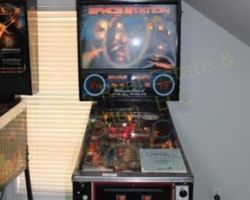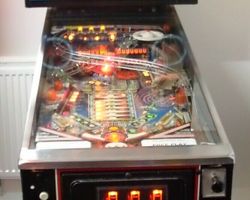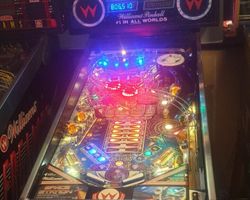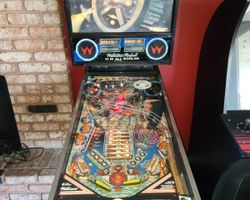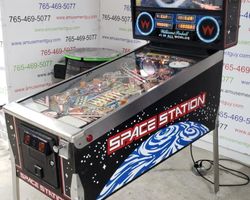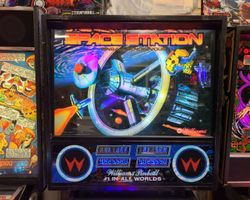Space Station
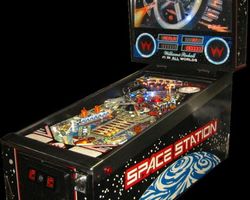
Average Prices: USD $400 to $1,900
Produced: December, 1987
Production Run: 3,804 units
Machine Type: Solid State Electronic
MPU: Williams System 11B
Players: 4
Concept by: Barry Oursler
Design by: Barry Oursler
Art by: Tim Elliot, Tim Elliott
Music by: Brian Schmidt
Sound by: Brian Schmidt
Software by: Ed Boon
The Williams "Space Station" pinball machine, released in December 1987, transported players into an orbital adventure, a journey through the cosmos from the comfort of the arcade floor. Manufactured by Williams Electronic Games, Inc., this solid-state electronic (SS) title emerged as an early showcase for the capabilities of the System 11B MPU, laying groundwork for future designs from the company. With 3,804 units produced between December 1987 and March 1988, "Space Station" carved out its niche, inviting players to dock, launch, and explore a captivating world beyond Earth's atmosphere.
The creative forces behind "Space Station" were a blend of established talent and rising stars. Barry Oursler, a prolific designer, helmed the project, conceiving the game's core theme and mechanical vision. Tim Elliot was responsible for the machine's distinct visual identity, including the playfield and backglass artwork. His work on the translite, depicting space shuttles, carries a poignant anecdote: Elliott was illustrating the very shuttle featured on the backglass when the real-world Challenger disaster occurred in January 1986. This personal connection, though somber, underlines the real-world inspiration woven into the machine's fantastical theme. Brian Schmidt crafted the immersive soundscape and music, contributing a memorable soundtrack that many enthusiasts recall as particularly catchy. Software development was handled by Ed Boon, while the familiar voice heard in the game's callouts belongs to Steve Ritchie, adding another layer of authenticity with his commanding delivery. "Space Station" was marketed with slogans like "A rendezvous with Pinball Destiny," signaling its ambitious theme and gameplay. Some early prototype variations exist, including a mini-playfield made of opaque black plastic instead of the translucent blue used in production, and an unpainted area on some production playfields where a prototype drop target was likely removed for cost efficiency. Different translite versions, some with punched light cutouts and others without, also hint at production adjustments during its run.
Signature Features and Design
"Space Station" distinguishes itself with several unique elements that enhance its thematic immersion and gameplay. Central to the experience is the physical turning space station model mounted on the playfield. This isn't merely a decorative toy; it acts as a crucial diverter, physically rotating to direct ramp shots towards either the left or right ball locks, adding a dynamic layer to strategic play. This tangible interaction with the machine's namesake object deepens player engagement.
Another standout is the game's distinctive lighting during multiball. Upon initiating a 3-ball multiball, the general illumination (GI) transitions from white to a vibrant green, creating a striking visual cue known as "Condition Green." This shift is not just aesthetic; it signals a heightened state of play and intensifies the excitement of multiball sequences. The absence of traditional flipper inlanes is a notable design choice, setting "Space Station" apart. This omission forces players to master direct flipper catches and precision shots, fundamentally altering ball control dynamics and contributing to a more challenging and skill-based game. Custom speech, provided by Steve Ritchie, further integrates the space theme, with callouts that guide and react to player actions, building an atmospheric experience.
Playfield and Mechanics
The "Space Station" playfield is a carefully crafted tableau of galactic exploration and pinball action. It features a standard two-flipper setup at the bottom, flanked by two slingshots, providing responsive control for the main playfield. Three pop bumpers located strategically within the upper playfield contribute to chaotic ball movement and score accumulation.
Major shots are spread throughout the layout. A prominent ramp on the right side of the playfield serves as a primary route to the ball locks, its destination dictated by the rotating space station diverter. Directly guarding this ramp is a single drop target, which, when hit, initiates the "Stop 'N' Score" feature, a timed sequence where subsequent ramp shots are multiplied. Above the flippers, a bank of three drop targets enhances the end-of-ball bonus multiplier, with repeated completion lighting an extra ball.
The upper playfield hosts a unique mini-playfield, a multi-leveled area with three lanes (labeled '1-2-3'). Balls are fed into this area via a right ball popper. Successful navigation of these lanes increases jet bumper scores and relights "Dock when lit" lights, crucial for multiball initiation. Below this mini-playfield are three additional lanes spelling 'U-S-A', which, when completed, increase the "Stop 'N' Score" multiplier and can light a special. Fifteen standup targets are distributed across the playfield, including targets to spell 'SHUTTLE' and 'STATION', both of which award random prizes upon completion. A center ball popper and the right ball popper (feeding the mini-playfield) serve as key points for scoring and multiball activation. A kickback on the left outlane offers a last-chance save, adding a layer of defensive strategy. The artwork by Tim Elliot saturates the playfield with sci-fi imagery, from galactic vistas to orbital hardware, complemented by an effective lighting scheme that uses flashers to highlight targets and modes, creating an engaging visual experience, particularly during the transformative "Condition Green" multiball.
Gameplay Dynamics
The core objective in "Space Station" revolves around preparing for and executing multiball. Players must "dock" two balls by shooting them into the left and right ball locks, a feat often requiring precise ramp shots dictated by the rotating space station diverter. Once two balls are docked and "Dock when lit" is active, hitting either the center ball popper or the right ball popper initiates a thrilling 3-ball multiball, transforming the playfield's general illumination to a pulsating green. During this high-energy multiball, the primary goal is to re-dock two balls to claim the significant "Rescue Jackpot."
Beyond the central multiball objective, several interconnected mechanics contribute to score accumulation and game progression. Spelling 'SHUTTLE' and 'STATION' by hitting their respective standup targets awards various prizes, ranging from extra points to extra balls or specials, adding an element of surprise. The "Stop 'N' Score" feature, activated by hitting the drop target in front of the ramp, introduces a timed scoring opportunity where subsequent ramp shots are significantly multiplied, encouraging aggressive play. Completing the 'U-S-A' lanes further boosts this multiplier, eventually lighting a special. The mini-playfield's '1-2-3' lanes are vital for increasing pop bumper value and relighting "Dock when lit" indicators. The three-bank drop targets directly increase the end-of-ball bonus multiplier, a crucial component of high scores, and hitting them four times lights an extra ball. A "Bonus Ball" feature offers a timed extra ball after the final ball in play, extended if multiball was achieved, providing a last-ditch effort to boost scores. The absence of inlanes fundamentally shapes gameplay, demanding greater flipper skill for ball control and making shots more challenging, often requiring precise post-passing or live catches rather than passive ball feeds. This design choice contributes to a more demanding yet rewarding player experience, where every shot counts.
Reception and Legacy
"Space Station" has garnered a largely positive reception within the pinball community, often considered an underrated machine that offers a compelling experience. Its strengths are frequently highlighted, particularly its well-executed space theme, which is brought to life through the detailed artwork, backglass, and the interactive turning space station model. Many players find the visuals immersive and appealing. Brian Schmidt's music and sound design are consistently praised, often cited as among the best of its era, with a catchy soundtrack that complements the on-screen action. Steve Ritchie’s custom callouts further enhance the thematic integration.
Gameplay is generally described as fun, challenging, and rewarding, striking a balance that makes it accessible for newer players while offering enough depth to entertain seasoned enthusiasts. The 3-ball multiball, especially when accompanied by the dramatic "Condition Green" lighting change, is a standout feature, creating an exciting and visually striking climax. The rotating space station diverter and the deliberate absence of inlanes are seen as creative and unique design choices that differentiate the game and add a distinct challenge. The lighting, with its effective use of flashers and the GI shift, is considered exemplary for its time. Furthermore, "Space Station" is often seen as providing good value, offering significant enjoyment for its typical price point.
However, "Space Station" is not without its points of contention. Some players find the gameplay can become repetitive over extended sessions, with a perceived heavy reliance on achieving multiball as the primary objective, leading to a somewhat simple rule set. The lack of inlanes, while unique, is a polarizing design choice. While it adds challenge and forces players to develop advanced ball control techniques, it can also lead to frustrating drains and make overall ball control more difficult for some. This design also contributes to what some perceive as challenging shots. Additionally, the upper playfield is occasionally described as cluttered. Regarding reliability, some reports suggest potential issues with the diverter mechanism and other components, which can require maintenance.
Despite these criticisms, the overall sentiment towards "Space Station" remains positive. It maintains a strong reputation as a captivating machine with a unique playfield layout and robust theme integration. Its influence is evident in its place as an early System 11B title, showcasing the platform's capabilities for dynamic features and lighting effects. Its distinctive gameplay elements, particularly the absence of inlanes and the interactive space station, set it apart and contributed to its lasting impression in pinball history, ensuring its place as a memorable and sought-after title for those who appreciate its unique blend of challenge and charm.
Sponsored Links
 Ebay Listings
Ebay Listings
 Auction Results
Auction Results
| Cost | Location | Date |
|---|---|---|
| USD $2,800 |  Maryland, United States Maryland, United States |
25 July, 2025 |
| USD $3,000 |  Illinois, United States Illinois, United States |
25 March, 2025 |
| USD $2,900 |  Iowa, United States Iowa, United States |
08 March, 2025 |
| USD $2,975 |  Indiana, United States Indiana, United States |
03 July, 2024 |
| USD $4,699 |  Kansas, United States Kansas, United States |
08 June, 2024 |
| USD $2,004 |  Nevada, United States Nevada, United States |
18 May, 2023 |
| USD $3,899 |  Illinois, United States Illinois, United States |
27 March, 2023 |
| USD $2,750 |  Illinois, United States Illinois, United States |
11 October, 2022 |
| GBP £2,500 |  Nuneaton, United Kingdom Nuneaton, United Kingdom |
02 October, 2022 |
| GBP £2,349 |  Nuneaton, United Kingdom Nuneaton, United Kingdom |
30 September, 2022 |


Private Policy · Search Website · Contact Us
As an eBay Partner, we may earn a commission from qualifying purchases made through links on this site, at no additional cost to you.
All trademarks and copyrighted materials remain property of their respective owners. All other content copyright 2007 - 2025 Pinpedia.

